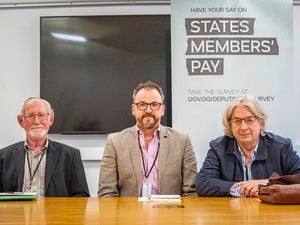Guernsey’s borrowing – the facts
Far from placing a burden on taxpayers, borrowing will accelerate Guernsey’s recovery and help create jobs and opportunity, as well as improving our environment and our infrastructure, as Deputy Lyndon Trott explains

THERE have been a number of questions and statements recently about the level of indebtedness of the States and the burden it places on the taxpayer of Guernsey.
Not all comments have been accurate, or well informed, so what’s the real picture?
Are we in debt up to our eyeballs?
The answer to that is a categorical no!
Guernsey has followed a prudent approach to public finances for generations which has put us in an excellent position entering this unprecedented period. We have strong reserves, along with a stable government and fiscally prudent approach, has led to us retaining a AA-credit rating – the same as the UK government.
The States entered this year with a strong financial position including a budget surplus, significant reserves and modest borrowing. However, unlike larger economies, Guernsey does not have its own central bank, so we do not have the option to initiate quantitative easing or increase the money supply in the economy in any meaningful way.
So, what debt do we have?
The States decided in 2013 to issue the first ever States of Guernsey sterling bond. A total of £330m. was borrowed but this wasn’t to fund public services. The money was borrowed to lend on to others, our own trading and associated entities, in order to reduce their cost of borrowing.
Approximately £163m. of this total has been lent on with a further £25m. of commitments awaiting finalisation. This funding is supporting critical national infrastructure in Guernsey, providing certainty and low rates for the borrowers which covers the cost of the interest payable and means there is no cost to the taxpayer.
The largest beneficiary of the bond proceeds to date has been the Guernsey Housing Association which has borrowed a total of £96m. of long-term money which helps to lower the cost of social housing in Guernsey.
There is approximately £140m. available for new lending, which is invested in the Consolidated Investment Fund ahead of being lent out. This lending can only be made where there is a secure income stream capable of repaying the debt without recourse to the tax payer.

We have established a bond reserve which is the vehicle for recording all of the investment returns achieved on this un-lent portion of the bond issue and for paying all of the costs, most notably the ‘coupon’ (or interest) due on the bond. At the end of 2019, the bond reserve had a positive balance of £18m. At the end of May the balance on this reserve was approximately £10m. This balance provides a buffer and again means that the taxpayer of Guernsey bears no burden in relation to this bond.
But what about the new £250m. debt that’s been taken on?
The Policy & Resources Committee has put in place a Revolving Credit Facility – or RCF – of £225m. having been given authority to borrow up to £250m., in this way, by the States of Deliberation. But that most definitely does not mean that we have borrowed £225m. and we may not at all. However, even if we do, we have a similar amount within our Contingency Reserve, our rainy-day savings fund, which covers this facility.
This facility gives us financial flexibility.
Don’t forget – we have assets of over £3bn and usable/accessible assets of about £500m. (if we don’t count the un-lent bond proceeds). The facility allows us to determine the most appropriate and advantageous time to liquidate these assets. It stops us from being ‘forced sellers’ of our assets and allows us to make the right decisions in the best interests of the Bailiwick of Guernsey.
So, what is an RCF?
An RCF provides us with committed funds. That is, the lender is under an obligation to advance money when requested. This provides us with more security than an uncommitted facility as is typically the case with an overdraft.
An RCF is used where the amount of funding required will fluctuate over the period. There is a maximum amount under the facility which the lenders have committed to make available on demand, but we can draw as much or little as we like and repay that when it suits us. So, if we need to draw down funds to ensure we can meet our commitments over a two-month period until we know that we will receive monies, for example ETI at the end of the quarter, then we can.
Interest is paid only on the amount drawn down. We believe, and so do our professional advisors, that this is the most appropriate and cost-effective mechanism for the States’ requirements, as our revenues fluctuate during the year.
There is a cost in that a non-utilisation fee, which is a fraction of the interest payable on drawn amounts, is paid on the amount not drawn down. This is the cost of having financial security and flexibility. However, should we decide that we no longer need the flexibility of the full £225m., we can cancel part of the facility and no longer incur charges on that amount.
The facility we have entered into is for an initial period of two years and contains an option for the States of Guernsey, which it is not obliged to exercise, to extend the termination date by up to two one-year periods.
Looking to the future – should we borrow to accelerate our recovery?
The simple answer to this is ‘yes’. And that is not simply the view of the States’ senior committee, but rather the global fiscal wisdom.
Our economic modelling suggests that without any intervention, recovery of our previous levels of ‘wealth’ in the economy (our GVA) could take up to a decade. That measure is not just an abstract economic calculation, it will mean fewer jobs for our community and less well-paid jobs at that.
If we do nothing, that will translate into a fall in taxes received by the States leading to a gap in public finances of roughly £400m. over that period. The States would be in a position where they would have to exhaust reserves or borrow (or both) simply to balance the books. This would inevitably lead to the need to radically cut the public services we are rightly proud of and would also likely result in higher taxes.
But that’s not the scenario I believe we should borrow for. We could instead invest in our recovery now. We could provide a fiscal stimulus to our economy that would help create jobs and opportunity as well as improving our environment and our infrastructure. We could cover the gap in public finances in the short term to allow our public services to continue to keep us safe and healthy. Sterling borrowing rates are at record lows with some investors paying the UK Government for the opportunity of lending to them!
Of course, the golden rule of borrowing and one which must be considered in such a small economy is that we should only borrow what we can afford to service. We are fortunate in that our strong and stable public finances; a strong credit rating and historically low interest rates mean that the level of debt which is sustainable for us is higher.
So, as I said in the States in April when we debated the prospect of borrowing to fund our recovery, my question remains – can we afford not to?
NOTE: Details have been checked for accuracy and confirmed as such by the States of Guernsey Treasury Division.





